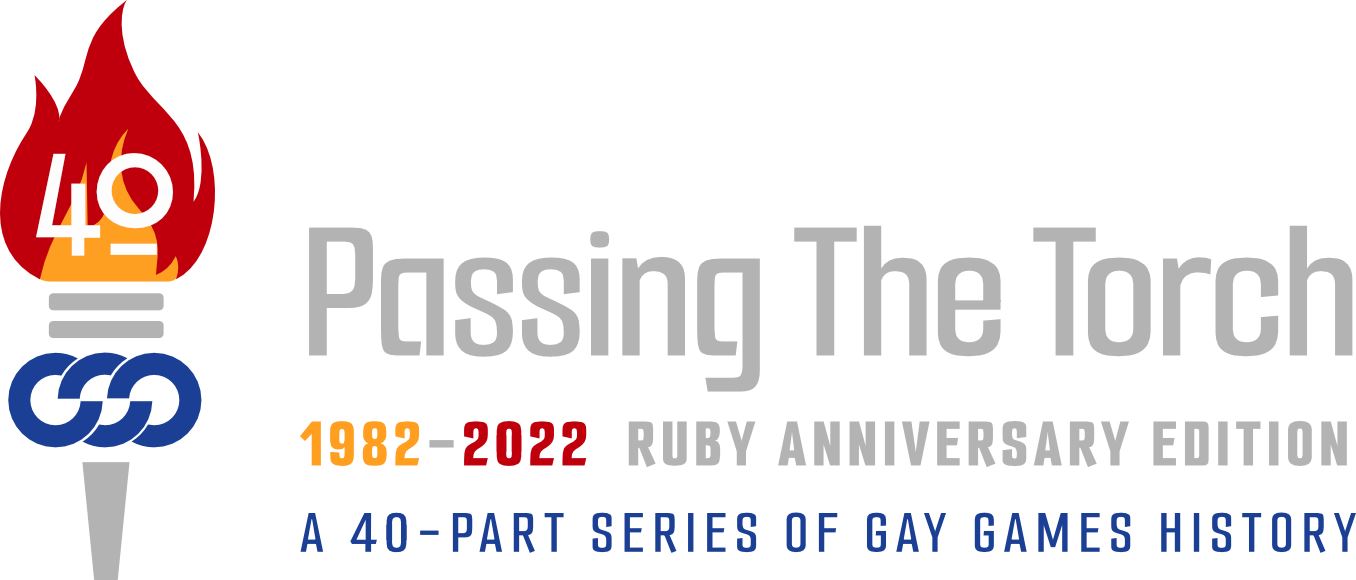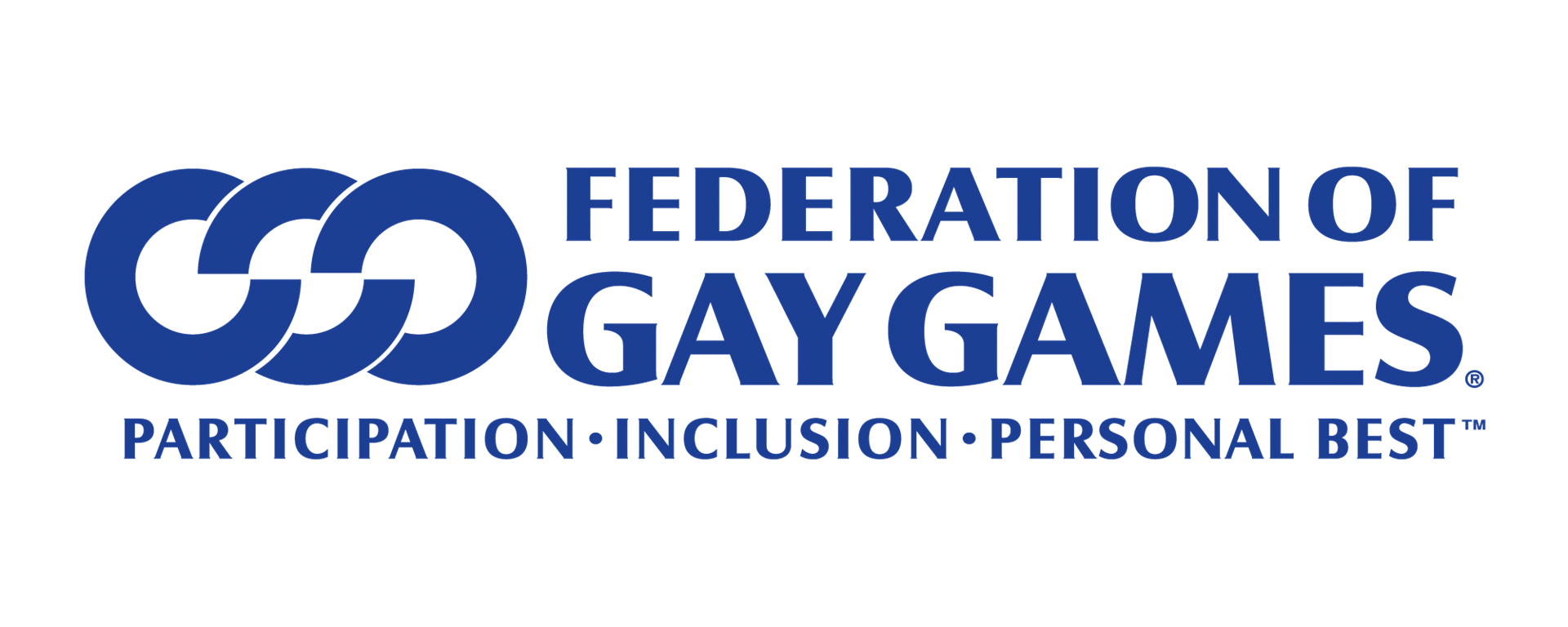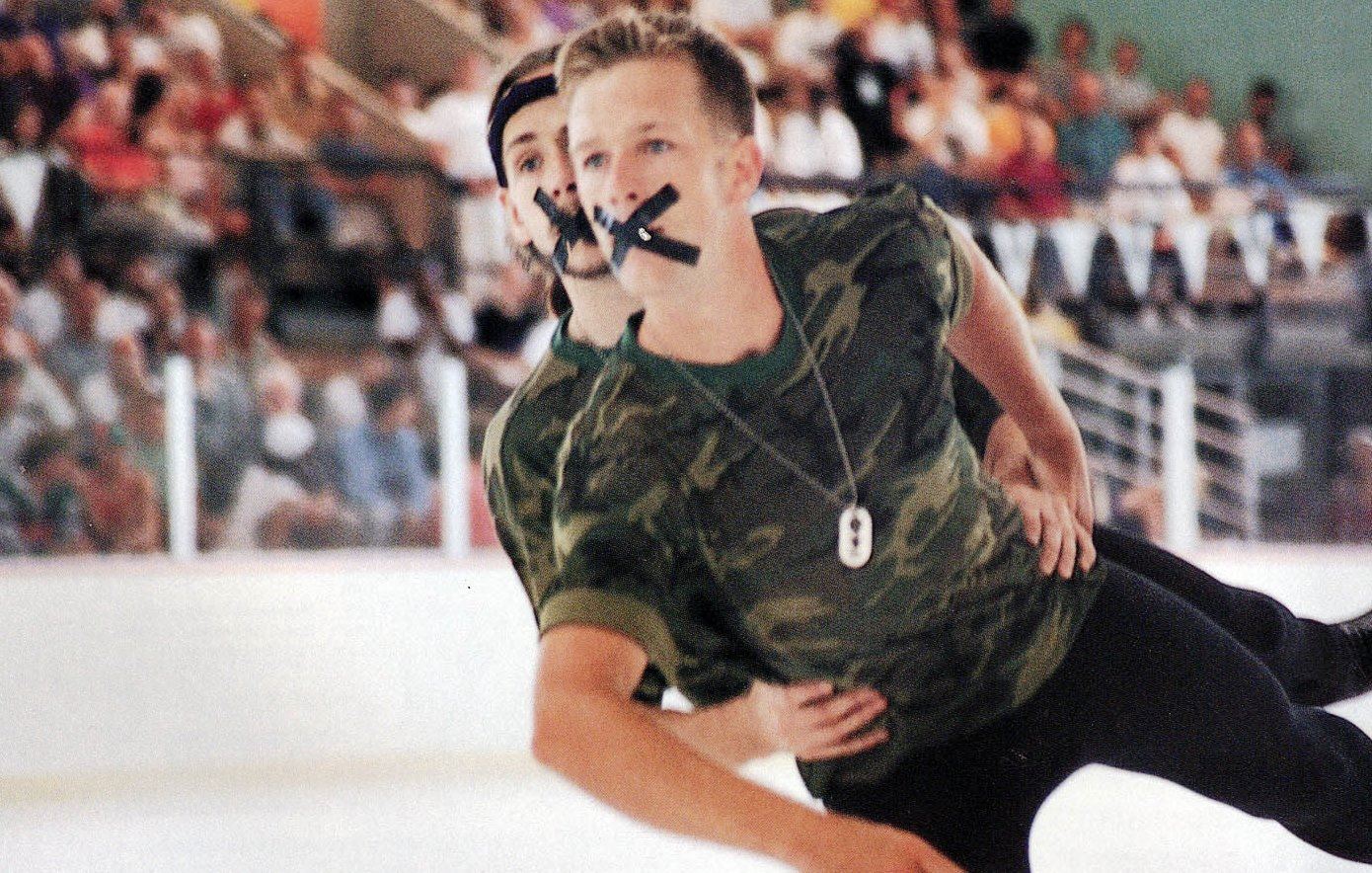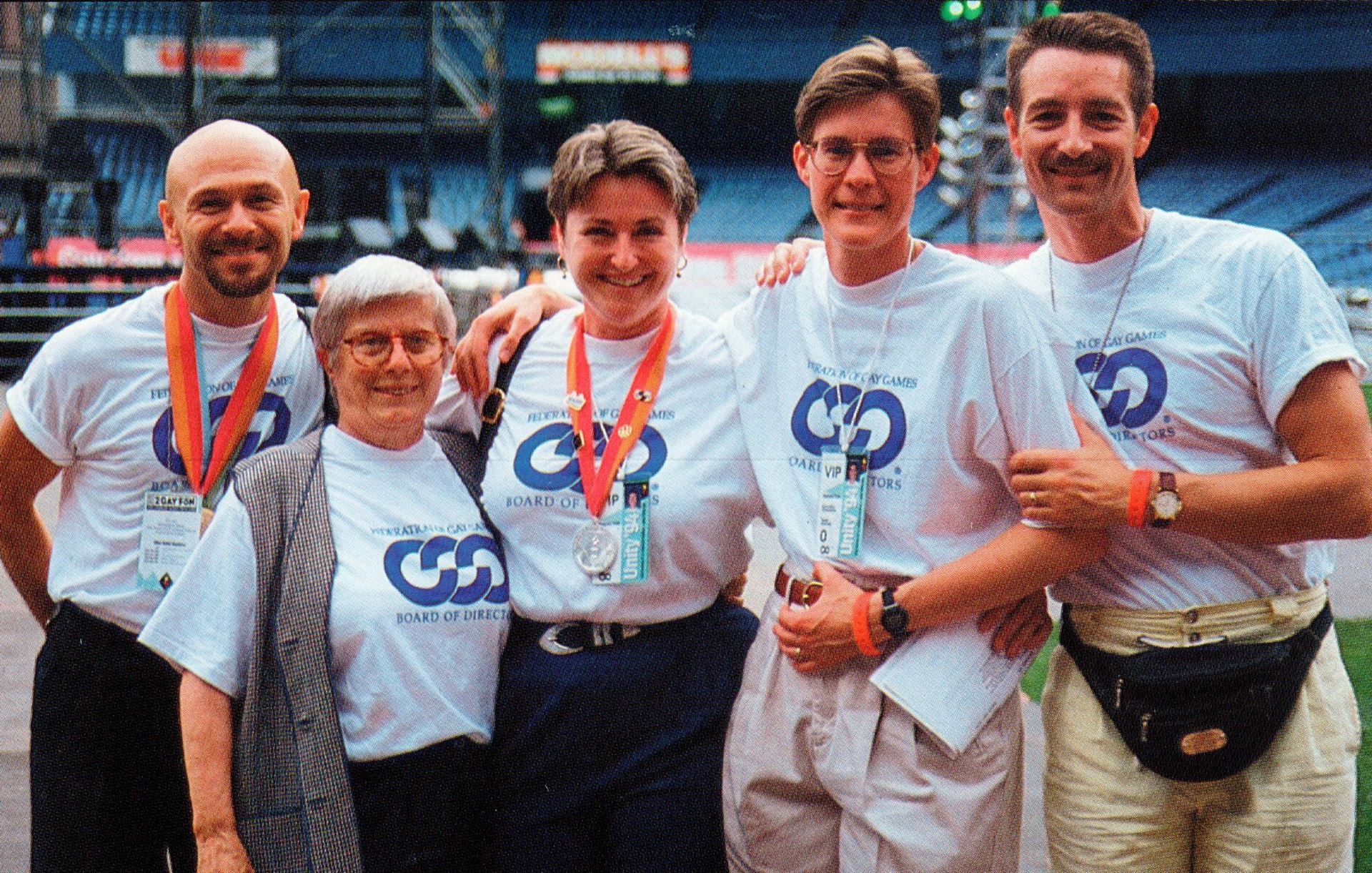Mending Fences, Global Expansion, and the HIV Waiver

Produced and curated by Federation of Gay Games Archivist Doug Litwin and FGG Honourary Life Member Shamey Cramer
with Ankush Gupta, FGG Officer of Communications
Read the entire "Passing The Torch" series as it is posted daily HERE.
Post 9 of 40 - 5 August - Mending Fences, Global Expansion, and the HIV Waiver
“Passing The Torch: Ruby Anniversary Edition” is a factual timeline of the major events that have been part of the Gay Games evolution since its inception. The series will run from 28 July 2022 - one month before the 40th anniversary of the original Opening Ceremony at San Francisco’s Kezar Stadium - through 5 September, the anniversary of Gay Games I Closing Ceremony. All postings will remain online and available for viewing at the FGG website.
* * *

The FGG logo, subject of the 1992 meeting with the US Olympic Committee
SUSAN KENNEDY: In 1992, the FGG Executive Committee went to Colorado Springs and met with then Executive Director Harvey Schiller, and staff members, regarding some lingering issues related to the logo. At that time, it was agreed that the “three interlocking circles' were acceptable to use. Another outcome at that time, was the USOC's willingness to list the Federation and host committee in their directory, which happened for a couple of years. Within a couple of years, Dr. Schiller departed the USOC to take a job with Turner Sports. After his departure, it appears that some of the logo problems reared their head again which led to work by Toby Butterfield and the 2000 agreement and IOC letter that FGG Co-Presidents Bill Wassmer and Susan Emerson unveiled in Sydney.
* * *

Richard Hogan at 2016 AGA in Sydney
RICHARD HOGAN: Over the years, I have served the Federation of Gay Games as Team Sydney’s voting delegate, an FGG Individual Director, FGG Site Selection Co-Chair and FGG Male Vice President. While I am honoured to be a ‘Life Member’ of both Team Sydney and the Federation of Gay Games, I am most proud of having received an ‘Order of Australia Medal’ for service to Sport Administration.
I first became involved in the Gay Games movement as a way to grieve the loss of my first partner, Phil who had recently died of AIDS. I moved from the USA to join him in Sydney and we had lived there together for nine years. I received my Australian permanent residency and later Australian citizenship on the basis of our relationship. Homosexuality had only just been legalised in Australia but the community was in a very sad, angry and distressed place. Like so many others, I was losing close friends at an alarming rate and needed something to improve my emotional state of mind.
I had read about the Gay Games in the local gay newspaper and was aware of a strong gay and lesbian sporting community but I had never participated in any of their events. I had recently become a volunteer with the Sydney Gay & Lesbian Mardi Gras which by that time had become the largest night time parade in the world. At a community fair I was made aware that they were partnering with Team Sydney in a bid to host Gay Games V. I immediately joined that effort and eventually became one of the Sydney bid presenters at the Federation of Gay Games’ Annual Meeting in Washington, DC in 1993. It was one of the best decisions in my life.
* * *
.jpg)
Anthony Alston at Gay Games VIII 2014 in Cologne
ANTHONY ALSTON: As I write this essay on my Federation of Gay Games (FGG) experience, I smile reflecting on the accomplishments that CHEER has made over the years and my contribution to these intertwined movements. “CHEER” refers to the cheerleaders that participate, fundraise and now compete at the Gay Games. CHEER San Francisco is the organization that I fondly call “the mothership” and has been thrilling crowds with their own unique brand of high energy performances around the world since 1980.

Hayward Raw Rahs, predecessor to CHEER SF, at Gay Games I in 1982
CHEER SF is the world’s first LGBTQ+ identified cheerleading team. Founded by Guy Andrade, the team was originally named the Hayward Raw Rahs. In 1990, the name was changed to the Bay Area Raw Rahs then in 1996 they became known as CHEER San Francisco. In 2004, CHEER SF established the CHEER For Life Foundation, an entity designed to enable and promote CHEER SF’s intent on giving back to its communities.

CHEER SF today, on steps of San Francisco City Hall
CHEER SF is an all volunteer based 501(c)3 organization with a philanthropic mission: “[To] inspire, entertain, and amaze audiences through powerful performance[s] while challenging others to be their best and supporting organizations that strengthen our communities.” CHEER SF’s beneficiaries support those living with life challenging conditions including HIV/AIDS and breast cancer.
* * *

Laura Moore (left) skating with her same-sex partner,, Gay Games IV, NYC 1994
LAURA MOORE: I first heard of the Gay Games in 1991. I had recently left my husband, bought a pair of figure skates and come out. It was all part of my grand plan to accept myself for who I was and to begin to get healthy, both physically and mentally. At the first NYC Pride March that I attended as an out lesbian and beginning figure skater, I was thrilled to see a few members of NY in ’94 sharing information about the Gay Games coming to NY.
The next week I visited a tiny volunteer office and tried to register for figure skating. I had a crazy fantasy about skating pairs with another women. A volunteer politely cut me off, explaining that the event would be in the summer. She also let me know that softball was popular with lesbians. I had avoided gym class as a child, not realizing until decades later that I might have actually met another lesbian if I had been interested in playing outside.
My interests in vintage dresses, antiques, and hosting dinner parties turned out to be more aligned with those of the gay male friends I was beginning to make in skating classes. I made a coffee date with Arthur Luiz. We decided to try to convince the organizers that people would pay money to see gay men in sparkles and spandex partnering each other on the ice. I only knew one other out lesbian figure skater at the time. That day, Arthur and I founded the International Gay Figure Skating Union and reached out to every skater we knew, looking to find a few out skaters.
Activist Ann Northrop, was on the NY in ’94 board and lived in my Chelsea apartment building. She loved the idea when I pitched it to her, and challenged me to prove it.
So, Arthur and I put on the first ever queer figure skating show (Pride Skate) in 1991. I financed it. We flew in a few skaters, sold tickets and invited Ann in her rental skates to join us on the ice for the big announcement.

Figure Skaters Trevor Kruse and Darren Singbiel of Toronto at Games IV figure skaters protesting "Don't Ask, Don't Tell" policy regarding gays in the U.S. military
The next thing we knew, Arthur and I were put in charge of running figure skating for Gay Games IV. It was a simpler time in the figure skating world. We wrote our own rules for the competition and easily received permission from the US and Canadian governing bodies for their skaters and judges to participate.
* * *

Susan Kennedy (second from right), FGG Co-President, Gay Games IV, NYC 1994
SUSAN KENNEDY: Gay Games IV: New York City 1994 raised the profile of the Games significantly, and as home to some of the leading AIDS activists and organizations, there was significant interest in mounting an effort to obtain what was known as a “10-day blanket waiver” that would allow individuals who were HIV positive / living with AIDS to enter the United States to participate in the Games. Under normal circumstances at that time, the United States barred nonresidents with HIV from entering the country.
Entry forms asked pointed questions about one’s HIV status, which would be used to deny entry. While many individuals chose to simply lie on their forms, there was concern that those traveling with medications, etc. would be subjected to discrimination and denied entry. The blanket waiver made it possible for participants to not declare their HIV status if they were entering the U.S. as a participant in Gay Games IV.
The Federation took the lead role with the U.S Government in this process. Co-President Rick Peterson and I began researching and reaching out to individuals within the various departments that would be involved in the decision making. Over time, we had established contact with representatives in the State Department, Health and Human Services, and Immigration and Naturalization Services. Fortunately, we were in the early years of the Clinton administration and while many staff members were federal employees who simply worked within a department through numerous administrations, we were fortunate to have high-ranking officials who were more receptive to our request than others might have been.
At the time, a “blanket waiver” had only been issued once and that was for the 1990 International AIDS Conference in San Francisco. Our job was to make the case that the Gay Games was an event that empowered people and provided the opportunity to participate in a positive event. We also discussed the fact that the Gay Games provided an opportunity to educate people about those living with HIV.
In the fall of 1993, when the Federation held its annual meeting in Washington D.C., Rick and I had the opportunity to meet with members of various departments face to face to make the case for the Gay Games. While those meetings were very positive, we still needed to continue our efforts. Finally, in March of 1994, the announcement was made by Attorney General, Janet Reno that the waiver and been granted.
I happened to be in D.C. at the time, having been invited to speak at a briefing of Regional INS Directors about the Gay Games. Since 1994 was also a World Cup year, INS realized that they were going to have thousands of people entering the country for both events. This briefing not only covered preparations for the World Cup; it also provided an opportunity for the directors to learn about the Gay Games and its. Also included in their two-day conference was INS Waiver Procedures and Sensitivity issues as well as cultural sensitivity overall.
The blanket waiver drew considerable attention, not all of it positive, but a TV appearance on the Larry King Live TV show, by Brent Nicholson Earle and I provided an opportunity to discuss the waiver and the positive aspects of the Gay Games.
Obtaining the waiver for Gay Games IV likely made the process to obtain the waiver for Gay Games VII in Chicago a much easier task and from my personal perspective continues to reinforce the fact that “Gay Games Change the World.” There’s no doubt it has made a difference.
* * *
